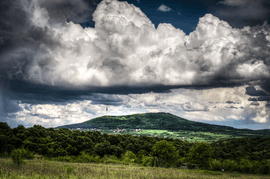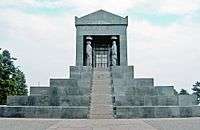Avala
| Avala | |
|---|---|
|
Мountain Avala | |
| Highest point | |
| Elevation | 511 m (1,677 ft) |
| Coordinates | 44°41′25″N 20°30′51″E / 44.69028°N 20.51417°ECoordinates: 44°41′25″N 20°30′51″E / 44.69028°N 20.51417°E |
| Naming | |
| Translation | Obstacle, shelter (Arabic) |
| Geography | |
 Avala | |
Avala (Serbian Cyrillic: Авала, pronounced [âv̞ala]) is a mountain in Serbia, overlooking Belgrade. It is situated in the south-eastern corner of the city and provides a great panoramic view of Belgrade, Vojvodina and Šumadija, as the surrounding area on all sides is mostly lowlands. It stands at 511 metres (1,677 ft) above sea level, which means that it enters the mountain category just by 11 meters.
Location
Avala is located 16 kilometers south-east of downtown Belgrade. The entire area of the mountain belongs to the Belgrade City area, majority of it being in the municipality of Voždovac, with the eastern slopes being in the municipality of Grocka, and the southernmost extension in the municipality of Sopot. It is possible that in the near future the entire area of Avala will create a separate municipality of Belgrade, named Avalski Venac.
Geography
Avala is a low type of the Pannonian island mountain, though it is actually the northernmost mountain in Šumadija. Until 600,000 years ago, when the surrounding low areas were flooded by the inner Pannonian Sea, Avala was an island, just as the neighboring mountains (Kosmaj, Fruška Gora, etc.), thus earning its geographical classification. However, the Avala remains an "island mountain" as the area around it, Pinosava plateau of the northern Low Šumadija, is low and mostly flat. In the north it extends into the woods of Stepin Lug.
The mountain is built of serpentinite, limestone and magmatic rocks, which are injected in the shape of cone (laccolith). Other peaks include Ladne vode (340 meters), Zvečara (347 meters), Sakinac (315 meters). The Avala had deposits of ores, most notably lead and mercury's ore of cinnabarite but mining activities which can be traced to the pre-Antiquity times, ceased in the 1960s. Avala is also a location where the mineral avalite, named after the mountain, was found. AA greenish mineral, chromian, magnesian or potassic alumosilicate (variety of the mineral illite), it was discovered by Serbian chemist Simo Lozanić who established its formula. Optically examined by the Israeli mineralogist Tamir Grodek who classified it as a member of the mica mineral group.[1]
Despite being only mountain in the area, the Avala is not a source of many rivers. The Topčiderka river, originating in the woods of Lipovička šuma on the south-west, flows on the western slopes of Avala, while river Bolečica flows on the eastern slopes. Other minor flows include the Vranovac, a tributary to the Bolečica. Small artificial lake near the village of Pinosava is created on the western slope of the mountain. The settlements in the area are notorious for problems with shortages of drinking water during summer.
Name and human history

In the Middle Ages, the town of Žrnov or "Avalski Grad" (Avala town) was located on top of Avala. In 1442. it was conquered by the Ottoman Empire, which built a new town in Žrnov's place as a counter-fortress to the Belgrade city fort, and renamed it "havale", which originally comes from Arabic and means "obstacle" or "shelter".
The mountain has been protected since 1859 [2] as a "monument of nature", or, by the modern standards, "sight of the exquisite values". That year, Prince Miloš Obrenović of Serbia issued an order for the Avala to get fenced and protected that way. Remains of the medieval Žrnov were removed in 1934 to make way for the Monument to the Unknown Hero. In the period of the Kingdom of Yugoslavia, the mountain was declared a national park, in 1936. In 1946, by the ukaz of the Presidium of the National Assembly of Serbia, Avala was reduced to the status of the "public property of general benefit" and placed under direct management of the Government of Serbia. In 1965, a 202 m high Avala TV Tower was constructed, one of the tallest structures in the Balkans, by the architects Uglješa Bogunović, Slobodan Janjić and M. Krstić. It had a restaurant-look out on 120 meters. The tower was destroyed during the NATO bombing of Serbia in 1999. Its total reconstruction began in 2006 and was officially opened at a ceremony on 21 April 2010. The new tower is almost the exact replica of the destroyed one, including the unique three-feet base. Belgrade's General Urbanistic Plan (GUP) for the 2001-2021 period defines the mountain as a sports and recreation area.
Settlements
Settlements near the mountain are not much populous. They include Ripanj (on the south, the largest one, with a population of 28,360 by the 2010 census of population), Pinosava (on the west, 2,839), Zuce (on the north-east, 2,024), Beli Potok (on the north, 3,417), all in the municipality of Voždovac, and Vrčin (on the east, 8,667), in the municipality of Grocka. A motion is in the process of creating a new municipality called Avalski Venac, which would include all these settlements and possible few others, but Zoran Alimpić, the acting mayor of Belgrade from September 2007 to August 2008, stated that new municipalities will probably not be formed before 2011 or 2012.
Wildlife

Despite being officially protected for almost 150 years, it was only in 2007 that preservation plans for the mountain were made. That way, Avala entered a circle of protected green areas of Belgrade, which also included the mountain of Kosmaj, the island of Veliko Ratno Ostrvo and the woods of Stepin Lug, with the forests of Košutnjak and Topčider to be added next. Protected areas of Avala spread over 489,13 hectares.
Aside from rich animal life, the Avala is known for its diverse plant life, despite not being a tall mountain. There are over 600 plant species living on the mountain. Some of them are protected by the law as natural rarities, like certain types of laburnum or box tree. The area is also abundant in medical herbs. High woods mostly consist of durmast oak, Turkey oak, hornbeam, beech, linden, black pine, black locust and other trees.
Transportation
Avala is well connected with Belgrade and other parts of Serbia via roads, highway and railroads.
Avalski drum ("Avala road") is an extension of the Boulevard of the Liberation, which directly connects the mountain to downtown Belgrade (via neighborhoods of Selo Rakovica, Jajinci, Banjica, Voždovac, Autokomanda, Karađorđev Park and Slavija). On the mountain, Avalski drum divides in three:
- one section is a circular road which goes to the top of the mountain.
- second section continues to the south-west, through Ripanj, Lipovička Šuma and Barajevo, and makes a connection to the major road in the western Serbia, Ibarska magistrala.
- third section goes south-east, parallel to the highway, through Trešnja and Ralja and further to the south and east (where it meets the highway).
Sub-Avalan settlements are directly connected to Belgrade by the bus lines of the city's public transportation, with terminus in the Belgrade's neighborhood of Trošarina.
The Belgrade–Niš highway, a section of one of the major European roads, European route E75, runs east of the mountain, through Vrčin. North of the mountain runs Kružni put, the most important road in the southern outskirts of Belgrade, which connects all the southern sections of the city. It is also a projected route of the future Belgrade beltway which would continue through the Bolečica river valley and the projected Vinča-Omoljica bridge over the Danube into Vojvodina.
Railroads also run on both sides of the mountain. Eastern branch is a section of the Belgrade-Niš railroad. It runs through the tunnel under the Avala at Beli Potok and then through Včrin. Western branch runs through Ripanj and the long "Ripanj tunnel" (though not under the Avala), and continues into western Serbia and further into Montenegro, as part of the Belgrade–Bar railway.
Tourism

Avala is a traditional picnic resort for Belgraders, but its capacities are not being used much. In 1984 number of tourists was only 15,700 despite over 1,5 million of inhabitants in Belgrade. Some attractions and capacities on the mountain include:
- Šuplja Stena, a former very popular children's resort, located on the mountain's wind rose; after the 1990s it turned into a residential place refugees from the Yugoslav Wars
- Avala Tower, landmark TV Tower that was destroyed during the 1999 NATO bombing of Serbia, later rebuilt (2009).
- Weekend-settlement on the southern slopes
- Motel "1000 Ruža" in Beli Potok
- Hotel "Avala"
- Trešnja resort, in the southernmost extension of the mountain
- Projected ethno-park above Beli Potok
- Monuments
- Mountaineering camps of Čarapićev brest and Mitrovićev dom
Monuments on Avala
Special attractions of the Avala are several monuments. They include:


- Monument to the Unknown Hero - dedicated to the unknown Serbian soldier from World War I; sculptured by Ivan Meštrović in the form of mausoleum with 8 caryatides (columns shaped like female figures, in this case each one representing a woman from a different historical region of Yugoslavia), it was completed in 1938. An earlier monument was erected in 1915 at the location by the German soldiers, on the orders of Field marshal August von Mackensen.
- Monument to the Soviet war veterans - dedicated to the members of the Soviet military delegation which died in an airplane crash on the Avala on October 19, 1964. They were flying to Belgrade for the celebration of the 20th anniversary of the liberation of Belgrade in the World War II, October 20, 1944, as Red Army forces participated in the expulsion of Germans. Among those killed in the crash were Marshal Sergey Semyonovich Biryuzov, chief of the General Staff and first deputy defense minister of the Soviet Union and General Vladimir Ivanovich Zhdanov. The monument was sculptured by Jovan Kratohvil.
- Memorial Park – dedicated to the victims of the World War II
- Monument to Vasa Čarapić - dedicated to Vasa Čarapić, one of the leaders of the First Serbian Uprising in 1804 and liberator of Belgrade from the Turks, built in Beli Potok, his birthplace, near the mountaineers home Čarapićev brest. It was sculptured in 1991 by Dušan Nikolić.
Mountaineering camp
Annually, from July 1 until July 10, a traditional camp of Serbian mountaineers is held on the Avala. Among other mountaineering activities, there are competitions in:
- Orienteering
- Climbing (on an outdoor Climbing wall)
- Mountain biking
- Mountain running
See also
References
- Mala Prosvetina Enciklopedija, Third edition (1986), Vol.I; Prosveta; ISBN 86-07-00001-2
- Jovan Đ. Marković (1990): Enciklopedijski geografski leksikon Jugoslavije; Svjetlost-Sarajevo; ISBN 86-01-02651-6
- Turističko područje Beograda, "Geokarta", 2007, ISBN 86-459-0099-8
External links
| Wikimedia Commons has media related to Avala. |
- Mountaineering camp on Avala (Serbian)